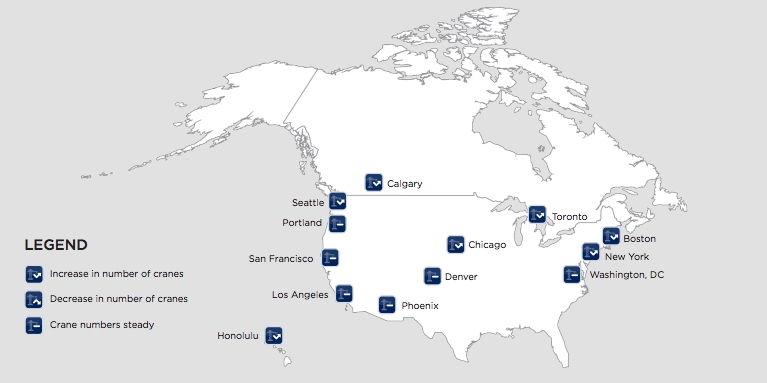
News
Toronto tops RLB Crane Index
Calgary also in top 10 cities with most crane activity
October 11, 2018 By Matt Jones
 Every city monitored for the Rider Levett Bucknall Crane Index for Q3 2018 either held steady or showed an increase in crane activity
Every city monitored for the Rider Levett Bucknall Crane Index for Q3 2018 either held steady or showed an increase in crane activity For the third consecutive reporting period, Toronto has been listed at the top of the Rider Levett Bucknall (RLB) Crane Index for Q3 2018. The Crane Index monitors crane activity in major cities. Calgary was also listed in the top 10 of the list, which includes 12 major American cities such as New York, Los Angeles and Seattle. Calgary and Toronto were the only Canadian cities included in the study.
“It’s a topic of interest,” says RLB quantity surveyor Joe Pendlebury. “Politicians seem to refer to the cranes during elections to show how much their cities are growing and I think it represents an indicator of the confidence in the market and how much money is being invested on larger scale projects. We think it’s a good visual indicator of the activity going on in a city at a given time.”
Pendlebury says that Toronto has been very busy with crane activity and at some points the Greater Toronto Area (GTA) had more cranes than all the U.S. cities combined. While Calgary also showed an increase in activity, its lower ranking on the list reflects a slow recovery from the impact of a drop in the price of oil.
The Crane Index only measures tower cranes, not any other types of cranes.
“There’s lots of mobile cranes around, but the identifier we chose was tower cranes, which usually indicate a larger scale project or a high-rise project,” says Pendlebury. “We actually physically go around to the sites in Toronto and identify which sites have them and how many cranes are on each site because there’s so many cranes.”
Other major Canadian cities, such as Vancouver or Montreal, could deserve a position on the Crane Index, and in fact could be highly rated. However, the reason that Calgary and Toronto are included is that RLB have offices in those cities and are able to collect data there. Pendlebury says RLB are interested in expanding to include other Canadian cities but they have to be mindful of logistic concerns.
“We have to be careful that its markets that we have familiarity with and that we have people on the ground who can actually do the work. That’s really our limiting factor right now.”
Pendlebury notes that one interesting statistic regarding Toronto’s performance is that the location of the cities activity has shifted in recent years. Though the overall crane counts have been increasing, the percentage in downtown Toronto has dropped. At one point, 55 per cent of the crane activity was in the downtown core but it has now dropped to 39 per cent. This indicates that most of the increase in crane activity has been in other parts of the GTA.
Print this page